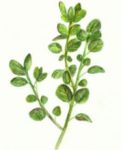The Colonial Kitchen Garden
Food
The Clark family’s kitchen and vegetable garden utilized every inch of space for food production. Corn, squash, gourds, beans, pumpkins, groundnuts and sunchokes, all Native American plants shared with early settlers, found their way into colonial kitchen gardens. This integration of native plants with herbs, vegetables and fruit brought from England helped the Clark family meet the challenge of feeding themselves and their livestock all year long.

Medicine
Seeds, roots, stems and bulbs made their way from England on the earliest colonial voyages. Herbs used in food preparation were often interchangeable as medicinal herbs—a readily available kitchen garden pharmacy commonly planted with borage, calendula, chamomile, fennel, horehound, lavender, mint, rosemary, sage, thyme and winter savory. Traditional Native American medicinal plants and remedies shared with early settlers proved to be a critical factor in surviving sickness and disease in a new land.
Household herbs
Like other families, the Clarks had little sanitation and limited methods of food preservation. Dyes for clothing were natural and plant-based. The colonial kitchen garden produced strewing herbs for deodorizing the home, pungent herbs for insecticides, savory herbs for cooking and preserving and dyeing herbs that allowed the Clark family a range of colors for clothing.
